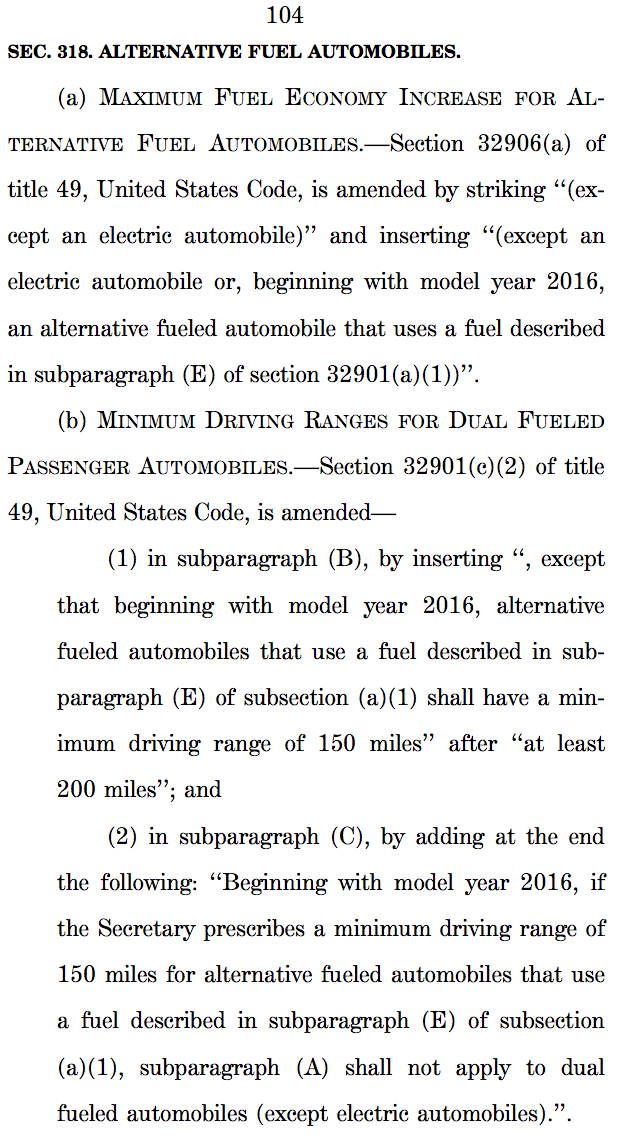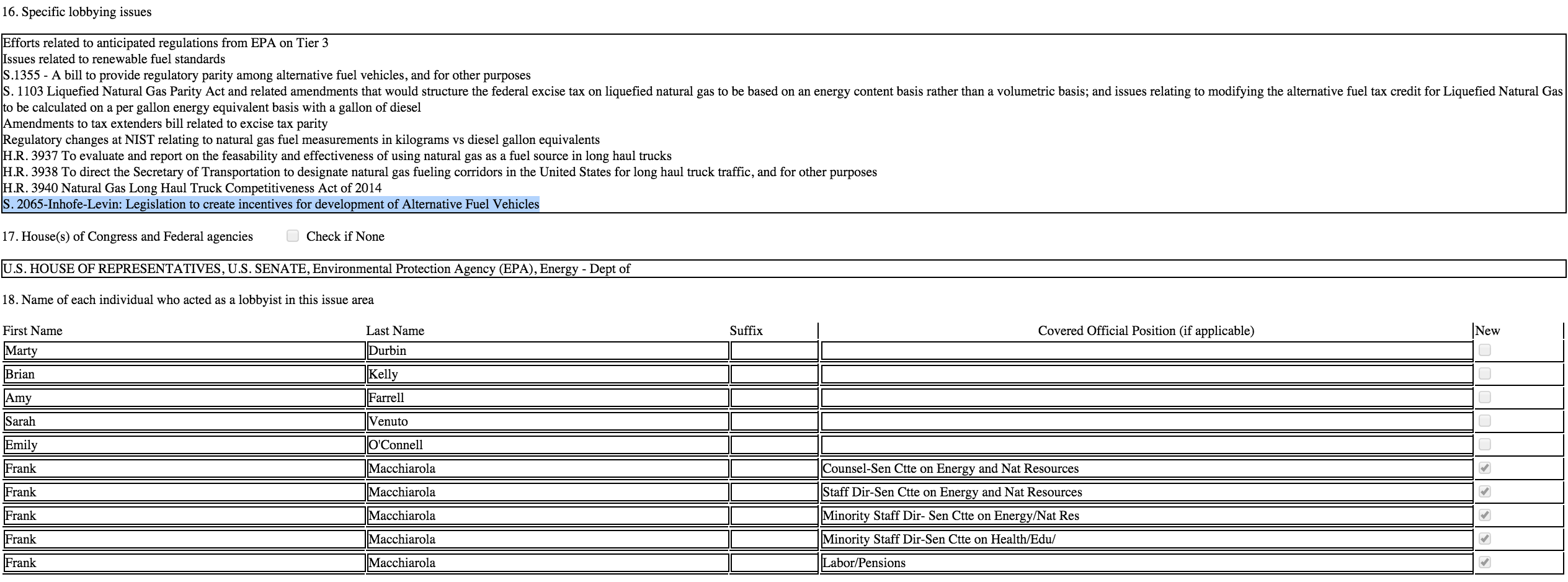One of the cornerstones of the Fueling U.S. Forward campaign is that the government shouldn’t be subsidizing clean energy solutions or electric vehicles—that government intervention isn’t allowing for a “level playing field.” See, for instance, the Koch Industries advertorial in The Hill that essentially laid out the framework for this messaging angle for their campaign.
Yet, as DeSmog revealed in an investigation into the pork-laden National Defense Authorization Act (NDAA) of 2015, Congress introduced federal financial support for natural gas-powered vehicles (NGVs).
In effect, the NDAA included a provision—introduced by notorious climate denier Senator James Inhofe—that opened the floodgates for natural gas vehicles (NGVs) in the U.S.—cars that would largely be fueled by gas obtained via fracking.
The section of the bill titled, “Alternative Fuel Automobiles” (on page 104) lays it out:

Image Credit: U.S. Government Publishing Office
The “fuel described in subparagraph (E)” refers to natural gas, found within Title 49 of the United States Code‘s section 32901.
It means, as with electric vehicles, natural gas automobile manufacturers will now also receive financial credits under the new Corporate Average Fuel Economy standards introduced by President Obama in May 2009.
Introduced by Climate Denier Inhofe
The provision was initially introduced in February by U.S. Sen. James Inhofe (R-OK), a climate science denier, as the Alternative Fuel Vehicle Development Act.
Inhofe called it a “bill that would incentivize the production and purchase of…natural gas vehicles (NGVs)” in a press release announcing its introduction.
“The booming natural gas industry in America is delivering a cheap, domestic energy source for our homes and businesses, but this fuel source is being underutilized in our vehicles,” said Inhofe. “I have introduced the Alternative Fuel Vehicle Development Act to help the rest of the nation tap into the benefits of using natural gas in vehicles.”
Though introduced at the beginning of the year, the bill did not advance and had only one co-sponsor: U.S.Sen. Carl Levin (D-MI), the soon-to-be-retired co-sponsor of the NDAA of 2015. Levin cited President Obama’s support of natural gas as a “bridge fuel” in introducing the bill on the Senate floor.
“The President outlined in his State of the Union his goal to achieve energy independence through the use of alternative fuels,” said Levin in his floor statement. “He specifically mentioned natural gas as the bridge fuel that can grow our economy, create jobs for the middle class, and reduce carbon pollution. I am pleased to introduce legislation today that takes a step toward meeting that goal.”
On the day of the NDAA‘s passage, Inhofe and Levin issued a follow-up press release on Section 318.
“Enactment of this bipartisan provision moves natural gas one step closer towards becoming a mainstream fuel for our everyday cars,” Inhofe declared. “Natural gas is an underutilized clean and abundant domestic energy resource for U.S. transportation in part due to outdated regulations. I am proud to have worked with Sen. Carl Levin to cut the red tape and help present Americans with another alternative to affordable, clean energy for their vehicles.”
Industry Lobbies, Then Cheerleads
Following the tried and true pattern, Big Oil — alongside the auto industry — first lobbied for the bill it likely wrote. Then once it passed, it praised it.
“Sen. Inhofe continues to be a champion for the NGV industry by introducing legislation that will encourage both automakers and vehicle purchasers to put more NGVs on American roads,” Richard Kolodziej, president of NGVAmerica said in a March press release after the initial introduction of the stand-alone bill.
Alongside the auto industry and other companies, America’s Natural Gas Alliance (ANGA) lobbied in quarter one,two and three for the bill’s passage, according to lobbying disclosure forms reviewed by DeSmog.

ANGA‘s lobbying team for the NGVs issue embodies the government-industry revolving door.
It included Amy Farrell, former deputy assistant administrator for the George W. Bush Administration’sEnvironmental Protection Agency (EPA) and the associate director for environment & regulations for the Bush White House Council on Environmental Quality (CEQ). Frank Macchiarola, former Republican minority staff director for the US Senate Committee on Energy and Natural Resources, also lobbied for the cause.
On the Democratic side, ANGA was flanked by its CEO Marty Durbin, nephew of U.S. Sen. Dick Durbin (D-IL) and a former lobbyist for the American Petroleum Institute. Prior to becoming a lobbyist, Durbin worked as a congressional staffer.
Upon the NDAA of 2015’s passage, ANGA praised both fracking-related provisions, expedited permitting for fracking on U.S. public lands and natural gas vehicles, in a press release. Inhofe included ANGA‘s natural gas vehicles provision statement in his press release, as well.
“This bill also promotes the tangible benefits that natural gas vehicles offer in increasing the use of an abundant and affordable American resource,” declared Macchiarola in ANGA‘s release. “This provision helps pave the way for the deployment of cleaner, more efficient vehicles on our highways and allows our nation to enjoy the environmental and economic advantages natural gas offers.”
Don’t believe the myth that EVs are the only electric vehicles being propped up by the government. Financial support for EVs pales in comparison to the roughly $20.5 billion received annually by the fossil fuel companies in the U.S.
